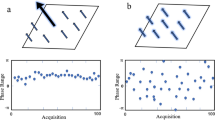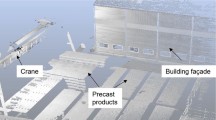Abstract
To recreate high-quality three-dimensional (3D) models of rock joints for quantitative roughness characterization more economically, portably, and quickly, it is necessary to assess the feasibility and accuracy of 3D reconstruction of rock joints using SfM & MVS photogrammetry with a camera in animation mode. A low-cost approach for 3D reconstruction by shooting videos was conducted to obtain point clouds of rock joints. Besides, to evaluate the accuracy of photogrammetry, high-resolution models of the same cases were collected using 3D laser scanning technology to compare the difference between models reconstructed by these two technologies, and the difference was calculated by one algorithm—Iterative Closest Point (ICP). Comparative analyses demonstrated that the models reconstructed by photogrammetry and the output of the laser scanning were in good agreement. Furthermore, these two different sources of point cloud data were used to realize quantitative characterization of the structural surface roughness via calculating JRC and θ*max/(C+1) values, and the related assessment results also showed good agreement. To ensure the precision of 3D models of rock joints, it is strongly advised that the 3D reconstruction be carried out using a camera that has been properly calibrated. Moreover, there is a significant difference in calibrated camera parameters between animation mode and image mode, which cannot be ignored in 3D reconstruction. Comparative analyses demonstrated that SfM & MVS photogrammetry with a DSLR camera in animation mode can generate a point cloud of multi-scale rock joints with acceptable accuracies for roughness estimation, proving the effectiveness of a low-cost approach for 3D reconstruction by shooting videos.





















Similar content being viewed by others
Data availability
Upon reasonable request, Yunfeng Ge, the study's first author, will provide the information and resources that back up its results.
Code availability
On reasonable request, the first author, Yunfeng Ge, will provide the code that underpins the study's conclusions.
References
Barton N (1973) Review of a new shear-strength criterion for rock joints. Engineering geology 7(4):287–332. https://doi.org/10.1016/0013-7952(73)90013-6
Barton N, Choubey V (1977) The shear strength of rock joints in theory and practice. Rock mechanics and rock engineering 10(1):1–54. https://doi.org/10.1007/BF01261801
Besl, P. and McKay, N. “Method for Registration of 3-D Shapes,” Proc. SPIE 1611, Sensor Fusion IV: Control Paradigms and Data Structures, (30 April 1992). https://doi.org/10.1117/12.57955
Bison, P., Bortolin, A., Cadelano, G., Ferrarini, G., Furlan, K., & Grinzato, E. (2012). Geometrical correction and photogrammetric approach in thermographic inspection of buildings. In 11th International Conference on Quantitative InfraRed Thermography (pp. 201-212). https://doi.org/10.21611/qirt.2012.285
Chen Y, Medioni G (1992) Object modelling by registration of multiple range images. Image and vision computing 10(3):145–155. https://doi.org/10.1016/0262-8856(92)90066-C
Develi K, Babadagli TT, Comlekci C (2001) A new computer-controlled surface-scanning device for measurement of fracture surface roughness. Computers & geosciences 27(3):265–277. https://doi.org/10.1016/S0098-3004(00)00083-2
Franklin JA, Maerz NH, Bennett CP (1988) Rock mass characterization using photo analysis. International Journal of Mining and Geological Engineering 6:97–112. https://doi.org/10.1007/BF00880801
Fecker, E., & Rengers, N. (1971, October). Measurement of large scale roughness of rock planes by means of profilograph and geological compass. In Proceedings symposium on rock fracture, Nancy, France (pp. 1-18).
Feng Q, Fardin N, Jing L, Stephansson O (2003) A new method for in-situ non-contact roughness measurement of large rock fracture surfaces. Rock Mechanics and Rock Engineering 36(1):3–25. https://doi.org/10.1007/s00603-002-0033-1
Ge Y, Kulatilake PH, Tang H, Xiong C (2014) Investigation of natural rock joint roughness. Computers and Geotechnics 55:290–305. https://doi.org/10.1016/j.compgeo.2013.09.015
Ge Y, Tang H, Xia D, Wang L, Zhao B, Teaway JW, Zhou T (2018) Automated measurements of discontinuity geometric properties from a 3D-point cloud based on a modified region growing algorithm. Engineering geology 242:44–54. https://doi.org/10.1016/j.enggeo.2018.05.007
Ge, Y., Chen, K., Liu, G., Zhang, Y., Tang, H. (2022). A low-cost approach for the estimation of rock joint roughness using photogrammetry. Engineering geology, Volume 305, 106726, ISSN 0013-7952. https://doi.org/10.1016/j.enggeo.2022.106726
Grasselli G, Egger P (2003) Constitutive law for the shear strength of rock joints based on three-dimensional surface parameters. International Journal of Rock Mechanics and Mining Sciences 40(1):25–40. https://doi.org/10.1016/S1365-1609(02)00101-6
Haneberg, W. C. (2007). Directional roughness profiles from three-dimensional photogrammetric or laser scanner point clouds. In 1st Canada-US rock mechanics symposium. OnePetro.
Hsiung SM, Ghosh A, Ahola MP, Chowdhury AH (1993) Assessment of conventional methodologies for joint roughness coefficient determination. International Journal of Rock Mechanics and Mining Sciences & Geomechanics Abstracts 30(7):329–343. https://doi.org/10.1016/0148-9062(93)90030-h
Huang SL, Oelfke SM, Speck RC (1992) Applicability of fractal characterization and modelling to rock joint profiles. International Journal of Rock Mechanics and Mining Sciences & Geomechanics Abstracts 29:89–98. https://doi.org/10.1016/0148-9062(92)92120-2
ISRM (1978) Suggested methods for the quantitative description of discontinuities in rock masses. International Journal of Rock Mechanics and Mining Sciences & Geomechanics Abstracts 15:319–68. https://doi.org/10.1007/s00603-013-0519-z
Kim DH, Poropat G, Gratchev I et al (2016) Assessment of the Accuracy of Close Distance Photogrammetric JRC Data. Rock Mechanics and Rock Engineering 49:4285–4301. https://doi.org/10.1007/s00603-016-1042-9
Lowe, D. G. (1999). Object recognition from local scale-invariant features, In Proceedings of the Seventh IEEE International Conference on Computer Vision, 2, 1150-1157, IEEE. https://doi.org/10.1109/ICCV.1999.790410
Maerz NH, Franklin JA, Bennett CP (1990) Joint roughness measurement using shadow profilometry. International Journal of Rock Mechanics and Mining Sciences & Geomechanics Abstracts 27(5):329–343. https://doi.org/10.1016/0148-9062(90)92708-M
Manessis, A., Hilton, A., Palmer, P., McLauchlan, P., & Shen, X. (2000, June). Reconstruction of scene models from sparse 3d structure. In Proceedings IEEE Conference on Computer Vision and Pattern Recognition. CVPR 2000 (Cat. No. PR00662) (Vol. 2, pp. 666-671). IEEE. https://doi.org/10.1109/CVPR.2000.854938
Goesele, M., Curless, B., & Seitz, S. M. (2006, June). Multi-view stereo revisited. In 2006 IEEE Computer Society Conference on Computer Vision and Pattern Recognition (CVPR'06) (Vol. 2, pp. 2402-2409). IEEE. https://doi.org/10.1109/CVPR.2006.199.
McLauchlan, P. F., & Murray, D. W. (1995, June). A unifying framework for structure and motion recovery from image sequences. In Proceedings of IEEE International Conference on Computer Vision (pp. 314-320). IEEE. https://doi.org/10.1109/ICCV.1995.466923
Pesce M, Galantucci LM, Percoco G, Lavecchia F (2015) A low-cost multi camera 3D scanning system for quality measurement of non-static subjects. Procedia Cirp 28:88–93. https://doi.org/10.1016/j.procir.2015.04.015
Poulin-Girard AS, Thibault S, Laurendeau D (2016) Influence of camera calibration conditions on the accuracy of 3D reconstruction. Optics express 24(3):2678–2686. https://doi.org/10.1364/OE.24.002678
Reeves, M. J. (1985). M.J. Rock surface roughness and frictional strength, International Journal of Rock Mechanics and Mining Sciences & Geomechanics Abstracts, 22(6), 429-442. https://doi.org/10.1016/0148-9062(85)90007-5
Remondino F, El-Hakim S (2006) Image-based 3-D modeling: a review. The Photogrammetric Record 21:269–291. https://doi.org/10.1109/MSP.2007.905702
Róg M, Rzonca A (2021) The Impact of Photo Overlap, the Number of Control Points, and the Method of Camera Calibration on the Accuracy of 3D Model Reconstruction. Geomatics and Environmental Engineering 15(2):67–87. https://doi.org/10.7494/geom.2021.15.2.67
Rusinkiewicz, S., & Levoy, M. (2001, May). Efficient variants of the ICP algorithm. In Proceedings third international conference on 3-D digital imaging and modeling (pp. 145-152). IEEE. https://doi.org/10.1109/IM.2001.924423
Seitz, S. M., Curless, B., Diebel, J., Scharstein, D., & Szeliski, R. (2006, June). A comparison and evaluation of multi-view stereo reconstruction algorithms. In 2006 IEEE computer society conference on computer vision and pattern recognition (CVPR'06) (Vol. 1, pp. 519-528). IEEE. https://doi.org/10.1109/CVPR.2006.19
Sheshadri, S., Dann, B., Hueser, T., & Scherberger, H. (2020). 3D reconstruction toolbox for behavior tracked with multiple cameras. Journal of Open Source Software, 5(45), 1849. https://doi.org/10.21105/joss.01849
Sturzenegger M, Stead D (2009) Close-range terrestrial digital photogrammetry and terrestrial laser scanning for discontinuity characterization on rock cuts. Engineering Geology 106(3–4):163–182. https://doi.org/10.1016/j.enggeo.2009.03.004
Triggs, B., McLauchlan, P. F., Hartley, R. I., & Fitzgibbon, A. W. (2000). Bundle adjustment—a modern synthesis. In Vision Algorithms: Theory and Practice: International Workshop on Vision Algorithms Corfu, Greece, September 21–22, 1999 Proceedings (pp. 298-372). Springer Berlin Heidelberg. https://doi.org/10.1007/3-540-44480-7_21
Tse R, Cruden DM (1979) Estimating joint roughness coefficients. International Journal of Rock Mechanics and Mining Sciences and Geomechanics Abstracts. 16(5):303–307. https://doi.org/10.1016/0148-9062(79)90241-9
Ullman S. (1979). The interpretation of structure from motion. Proceedings Of the Royal Society of London Biological. 203405–426. https://doi.org/10.1098/rspb.1979.0006
Westoby MJ, Brasington J, Glasser NF, Hambrey MJ, Reynolds JM (2012) ‘Structure-from-Motion’photogrammetry: A low-cost, effective tool for geoscience applications. Geomorphology 179:300–314. https://doi.org/10.1016/j.geomorph.2012.08.021
Xia X, Zhang X, Fayek S, Yin Z (2021) A table method for coded target decoding with application to 3-D reconstruction of soil specimens during triaxial testing. Acta Geotechnica 16:3779–3791. https://doi.org/10.1007/s11440-021-01343-1
Yu X, Vayssade B (1991) Joint profiles and their roughness parameters. International Journal of Rock Mechanics and Mining Sciences & Geomechanics Abstracts 28(4):333–336. https://doi.org/10.1016/0148-9062(91)90598-G
Zhang X, Li L, Chen G, Lytton R (2015) A photogrammetry-based method to measure total and local volume changes of unsaturated soils during triaxial testing. Acta Geotechnica 10:55–82. https://doi.org/10.1007/s11440-014-0346-8
Acknowledgments
This work was supported by the National Natural Science Foundation of China (No. 42077264) and the Guiding Scientific Research Project of the Hubei Provincial Department of Education (No. B2022260). We are grateful to Prof. Xiong Zhang from the Missouri University of Science and Technology for his assistance with photogrammetry. The editor of this work and the reviewers deserve particular thanks from the writers for their insightful criticism.
Funding
National Natural Science Foundation of China,No. 42077264,Guiding Scientific Research Project of Hubei Provincial Department of Education,No. B2022260
Author information
Authors and Affiliations
Contributions
Yunfeng Ge: Conceptualization, Data curation, Formal analysis, Investigation, Methodology, Resources, Software, Supervision, Validation, Visualization, Writing-original draft. Kaili Chen: Data curation, Software, Validation, Visualization, Writing-original draft. Geng Liu: Visualization, Writing-original draft. Huiming Tang: Data curation, Conceptualization, Funding acquisition. Qian Chen: Data curation, Investigation. Weixiang Chen: Data curation. Zhiguo Xie: Software.
Corresponding author
Ethics declarations
Competing interests
The authors declare no competing interests.
Conflicts of interest
There are no conflicts of interest, according to the authors.
Additional information
Communicated by: H. Babaie
Publisher's Note
Springer Nature remains neutral with regard to jurisdictional claims in published maps and institutional affiliations.
Rights and permissions
Springer Nature or its licensor (e.g. a society or other partner) holds exclusive rights to this article under a publishing agreement with the author(s) or other rightsholder(s); author self-archiving of the accepted manuscript version of this article is solely governed by the terms of such publishing agreement and applicable law.
About this article
Cite this article
Ge, Y., Chen, K., Liu, G. et al. Roughness Estimation of Multi-Scale Rock Joints based on SfM & MVS Photogrammetry with A DSLR Camera in Animation Mode. Earth Sci Inform 16, 3489–3509 (2023). https://doi.org/10.1007/s12145-023-01093-6
Received:
Accepted:
Published:
Issue Date:
DOI: https://doi.org/10.1007/s12145-023-01093-6




